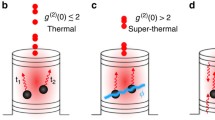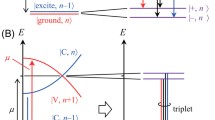Abstract
A quantum behavior of the light emitted by exciton polaritons excited in a pillar semiconductor microcavity with embedded quantum well is investigated. Considering the bare excitons and photon modes as coupled quantum oscillators allows for an accurate accounting of the nonlinear and dissipative effects. In particular, using the method of the quantum states representation in a quantum phase space via quasiprobability functions (namely, a P-function and a Wigner function), we study the impact of the laser and the exciton-photon detuning on the second order correlation function of the emitted photons. We determine the conditions under which the phenomena of bunching, giant bunching, and antibunching of the emitted light emerge. In particular, we predict the effect of a giant bunching for the case of a large exciton to photon population ratio. Within the domain of parameters supporting a bistability regime we demonstrate the effect of bunching of photons.






Similar content being viewed by others

References
J.M. Gérard, D. Barrier, J.Y. Marzin et al., Appl. Phys. Lett. 69, 449 (1996). https://doi.org/10.1063/1.118135
A. Baas, J. Karr, H. Eleuch and E. Giacobino, Phys. Rev. A 69, 023809 (2004). https://doi.org/10.1103/physreva.69.023809
W. Choi, J.-H. Lee, K. An et al., Phys. Rev. Lett. 96, 093603 (2006). https://doi.org/10.1103/PhysRevLett.96.093603
B. Ann, Y. Song, J. Kim et al., Sci. Rep. 9, 17110 (2019). https://doi.org/10.1038/s41598-019-53525-3
H. Abbaspour, G. Sallen, S. Trebaol et al., Phys. Rev. B 92, 165303 (2015). https://doi.org/10.1103/physrevb.92.165303
S.R.K. Rodriguez, W. Casteels, F. Storme et al., Phys. Rev. Lett. 118, 247402 (2017). https://doi.org/10.1103/PhysRevLett.118.247402
T. Fink, A. Schade, S. Höfling et al., Nat. Phys. 14, 365–369 (2017). https://doi.org/10.1038/s41567-017-0020-9
H. Deng, G. Weihs, C. Santori et al., Science 298, 199–202 (2002). https://doi.org/10.1126/science.1074464
A. Verger, C. Ciuti, I. Carusotto, Phys. Rev. B 73, 193306193306 (2006). https://doi.org/10.1103/PhysRevB.73.193306
M. Klaas, H. Flayac, M. Amthor et al., Phys. Rev. Lett. 120, 017401 (2018). https://doi.org/10.1103/physrevlett.120.017401
S.S. Demirchyan, T.A. Khudaĭberganov, I.Yu. Chestnov and A. P. Alodzhants, J. Opt. Technol. 84, 75 (2017). https://doi.org/10.1364/jot.84.000075
P.D. Drummond, C.W. Gardiner, Phys. A Math. Gen. 13, 2353–2368 (1980). https://doi.org/10.1088/0305-4470/13/7/018
P.D. Drummond, K.J. McNeil, D.F. Walls, Opt. Acta Int. J. Opt. 321, 27 (1980). https://doi.org/10.1080/713820226
H. Jabri, Phys. Rev. A 101, 053819 (2020). https://doi.org/10.1103/PhysRevA.101.053819
F. Zou, D.-G. Lai, J.-Q. Liao, Opt. Express 28, 16175–16190 (2020). https://doi.org/10.1364/OE.391628
A.V. Yulin, O.A. Egorov, F. Lederer, D.V. Skryabin, Phys. Rev. A 78, 061801061801 (2008). https://doi.org/10.1103/PhysRevA.78.061801
C. Gardiner, Stochastic Methods: a Handbook for the Natural and Social Sciences, 4th edn. (Springer, Berlin, 2009). (ISBN 978-3-540-70712-7)
H. Haken, Synergetics: Introduction and Advanced Topics (Springer Science & Business Media, New York, 2013). (ISBN 978-3-662-10184-1)
W. Casteels, F. Storme, A. Le Boité, C. Ciuti, Phys. Rev. A 93, 033824 (2016). https://doi.org/10.1103/PhysRevA.93.033824
W. Casteels, R. Fazio, C. Ciuti, Phys. Rev. A 95, 012128 (2017). https://doi.org/10.1103/PhysRevA.95.012128
Th.K. Mavrogordatos, EPL 116, 54001 (2016). https://doi.org/10.1209/0295-5075/116/54001
E. Zubizarreta Casalengua, J.C. López Carreño, F.P. Laussy, E. del Valle, Laser Photonics Rev. 14, 1900279 (2020). https://doi.org/10.1002/lpor.201900279
A. Delteil, T. Fink, A. Schade et al., Nat. Mater. 18, 219–222 (2019). https://doi.org/10.1038/s41563-019-0282-y
L. Mandel, Opt. Lett. 4(7), 205–207 (1979). https://doi.org/10.1364/OL.4.000205
Albrecht Werner, Oleg A.. Egorov, Falk Lederer, Phys. Rev. B 89, 245307 (2014). https://doi.org/10.1103/physrevb.89.245307
T. Khudaiberganov, S. Arakelian, I.O.P. Conf, Ser. Mater. Sci. Eng. 896, 012126 (2020). https://doi.org/10.1088/1757-899X/896/1/012126
G. Muñoz-Matutano, A. Wood, M. Johnsson et al., Nat. Mater. 18, 213–218 (2019). https://doi.org/10.1038/s41563-019-0281-z
K.V. Kheruntsyan, J. Opt. B Quantum Semiclass. Opt. 1, 225 (1999). https://doi.org/10.1088/1464-4266/1/2/005
E.T. Whittaker, G.N. Watson, A Course of Modern Analysis, 4th edn. (Cambridge University Press, Cambridge, 2013). (ISBN 978-0-511-60875-9)
G.N. Watson, A Treatise on the Theory of Bessel Functions, 2nd edn. (Cambridge University Press, Cambridge, 1995). (ISBN 0-521-48391-3)
Acknowledgements
The research was supported by the Ministry of Science and Higher Education of the Russian Federation under Agreement no. 0635-2020-0013. The work was also supported by the RFBR within the framework of the scientific projects no. 20-02-00515 and 21-52-10005. I.Yu.C. acknowledges the support from the Grant of the President of the Russian Federation for state support of young Russian scientists no. MK-5318.2021.1.2.
Author information
Authors and Affiliations
Contributions
TAK has carried out the analytical and numerical calculations. TAK and IYuC analysed and interpreted the obtained results and prepared the main text of the paper. All the authors contributed to the writing of the final form of the manuscript.
Corresponding author
Additional information
Publisher’s note
Springer Nature remains neutral with regard to jurisdictional claims in published maps and institutional affiliations.
Appendices
Appendix 1: Derivation of basic equations based on the P-representation method
Using the generalized P-representation and using the c-numbers instead of operators we turn from master equation (2) to the Fokker–Planck equation for the P-function [12]:
where \(\chi\) and \(\phi\)—are c-numbers. A solution of the Fokker–Planck equation (8) is obtained by the method of potentials in the adiabatic limit [12]:
where \(\gamma =\gamma _\mathrm{ex} +\frac{\omega _\mathrm{R}^{2} \gamma _\mathrm{ph} }{\gamma _\mathrm{ph}^{2} +\varDelta _\mathrm{ph}^{2} } -i\left( \varDelta _\mathrm{ex} +\frac{\varDelta _\mathrm{ph} \omega _\mathrm{R}^{2} }{\gamma _\mathrm{ph}^{2} +\varDelta _\mathrm{ph}^{2} } \right)\), \(\sigma =\omega _\mathrm{R} \frac{\gamma _\mathrm{ph} -i\varDelta _\mathrm{ph} }{\alpha \left( \gamma _\mathrm{ph}^{2} +\varDelta _\mathrm{ph}^{2} \right) }\) and N—is a normalization constant.
We use solution (9) to calculate the correlation functions of any order for excitons:
where \(\varGamma\) is a gamma function and \({}_{0} \mathrm{F}_{2}\) is a hypergeometric function.
The stochastic differential equations can be obtained in the Ito calculus by converting the Fokker–Planck equation (8) into the Ito form [12]:
where \(\xi \left( t\right)\) is an independent stochastic function, whose correlation functions satisfy the following relations: \(\left\langle \xi \left( t\right) \right\rangle =0\), \(\left\langle \xi ^{+} \left( t\right) \right\rangle =0\), \(\left\langle \xi \left( t\right) \xi ^{+} \left( t'\right) \right\rangle =\delta \left( t-t'\right)\).
Appendix 2: Derivation of the Wigner function
We use the Wigner function for a visual presentation of the statistical properties of the exciton-polariton system based on the steady-state solution for the P-function (9). The Wigner function one can be expressed in terms of the P-representation as follow [28]:
Then substituting (9) in (12), changing variables in the integral as \(x\rightarrow -E_\mathrm{d}\sigma /t\) and using the Schläfli’s integral [29]
we obtain the following relation for the excitonic Wigner function:
where \(N'\) is a normalization constant, defined by the following expression:
Here we use the following expansion of the power series of the Bessel function [30]
According to (14) the Wigner function is always positive and equals the squared modulus of the Bessel function with the complex index \(-i\gamma /\alpha -1\). The Wigner function of photons is obtained from the governing principle (3):
where we introduced new normalized constant \(N''=\frac{\omega _\mathrm{R}^{2} }{\varDelta _\mathrm{ph}^{2} +\gamma _\mathrm{ph}^{2} } N'.\)
Rights and permissions
About this article
Cite this article
Khudaiberganov, T.A., Chestnov, I.Y. & Arakelian, S.M. Quantum statistics of light emitted from a pillar microcavity. Appl. Phys. B 128, 117 (2022). https://doi.org/10.1007/s00340-022-07835-6
Received:
Accepted:
Published:
DOI: https://doi.org/10.1007/s00340-022-07835-6



